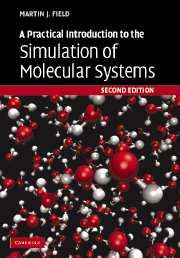Book contents
- Frontmatter
- Contents
- Preface to the first edition
- Preface to the second edition
- 1 Preliminaries
- 2 Chemical models and representations
- 3 Coordinates and coordinate manipulations
- 4 Quantum chemical models
- 5 Molecular mechanics
- 6 Hybrid potentials
- 7 Finding stationary points and reaction paths on potential energy surfaces
- 8 Normal mode analysis
- 9 Molecular dynamics simulations I
- 10 More on non-bonding interactions
- 11 Molecular dynamics simulations II
- 12 Monte Carlo simulations
- Appendix 1 The pDynamo library
- Appendix 2 Mathematical appendix
- Appendix 3 Solvent boxes and solvated molecules
- Bibliography
- Author index
- Subject index
3 - Coordinates and coordinate manipulations
Published online by Cambridge University Press: 03 December 2009
- Frontmatter
- Contents
- Preface to the first edition
- Preface to the second edition
- 1 Preliminaries
- 2 Chemical models and representations
- 3 Coordinates and coordinate manipulations
- 4 Quantum chemical models
- 5 Molecular mechanics
- 6 Hybrid potentials
- 7 Finding stationary points and reaction paths on potential energy surfaces
- 8 Normal mode analysis
- 9 Molecular dynamics simulations I
- 10 More on non-bonding interactions
- 11 Molecular dynamics simulations II
- 12 Monte Carlo simulations
- Appendix 1 The pDynamo library
- Appendix 2 Mathematical appendix
- Appendix 3 Solvent boxes and solvated molecules
- Bibliography
- Author index
- Subject index
Summary
Introduction
In the last chapter we explored various ways of specifying the composition of a molecular system. Many of these representations contained not only information about the number and type of atoms in the system but also the atoms' coordinates, which are an essential element for most molecular simulation studies. Given the nature of the system's atoms and their coordinates the molecular structure of the system is known and it is possible to deduce information about the system's physical properties and its chemistry. The generation of sets of coordinates for particular systems is the major goal of a number of important experimental techniques, including X-ray crystallography and NMR spectroscopy, and there are data banks, such as the PDB and the Cambridge Structural Database (CSD), that act as repositories for the coordinate sets of molecular systems obtained by such methods.
There are several alternative coordinate systems that can be used to define the atom positions. For the most part in this book, Cartesian coordinates are employed. These give the absolute position of an atom in three-dimensional space in terms of its x, y and z coordinates. Other schemes include crystallographic coordinates in which the atom positions are given in a coordinate system that is based upon the crystallographic symmetry of the system and internal coordinates that define the position of an atom by its position relative to a number of other atoms (usually three).
The aim of this chapter is to describe the various ways in which coordinates can be analysed and manipulated. Because numerous analyses can be performed on a set of coordinates, only a sampling of some of the more common ones will be covered here.
- Type
- Chapter
- Information
- Publisher: Cambridge University PressPrint publication year: 2007

